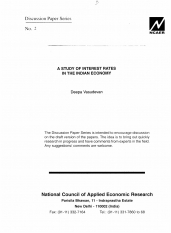A Study of Interest Rates in the Indian Economy
Deepa Vasudevan
May 1999
Conventional economic analysis assumes the existence of 'the interest rate" - a guiding rate that is representative of the interest rate structure and appropriate for use in interest rate modelling. In developing countries like India it is difficult to identify this rate because the market for funds is highly fragmented and collectively generates a plethora of unconnected interest rates. This paper attempts to identify such a rate by examining some important short-term and medium term interest rates in the Indian economy. In general, as the financial sector of an economy is liberalised, free flow of funds between different market segments ensure greater co-movement between different rates, so that any market rate can be considered as a representative rate for the economy. Evidence shows that financial sector liberalisation has had some impact on Indian interest rates in this direction. An examination of the correlations between different rates during the period 1993-91 reveals that linkages between different rates improved substantially in the second half of this period, after reforms picked up pace.
National Growth and Macroeconomic Centre







